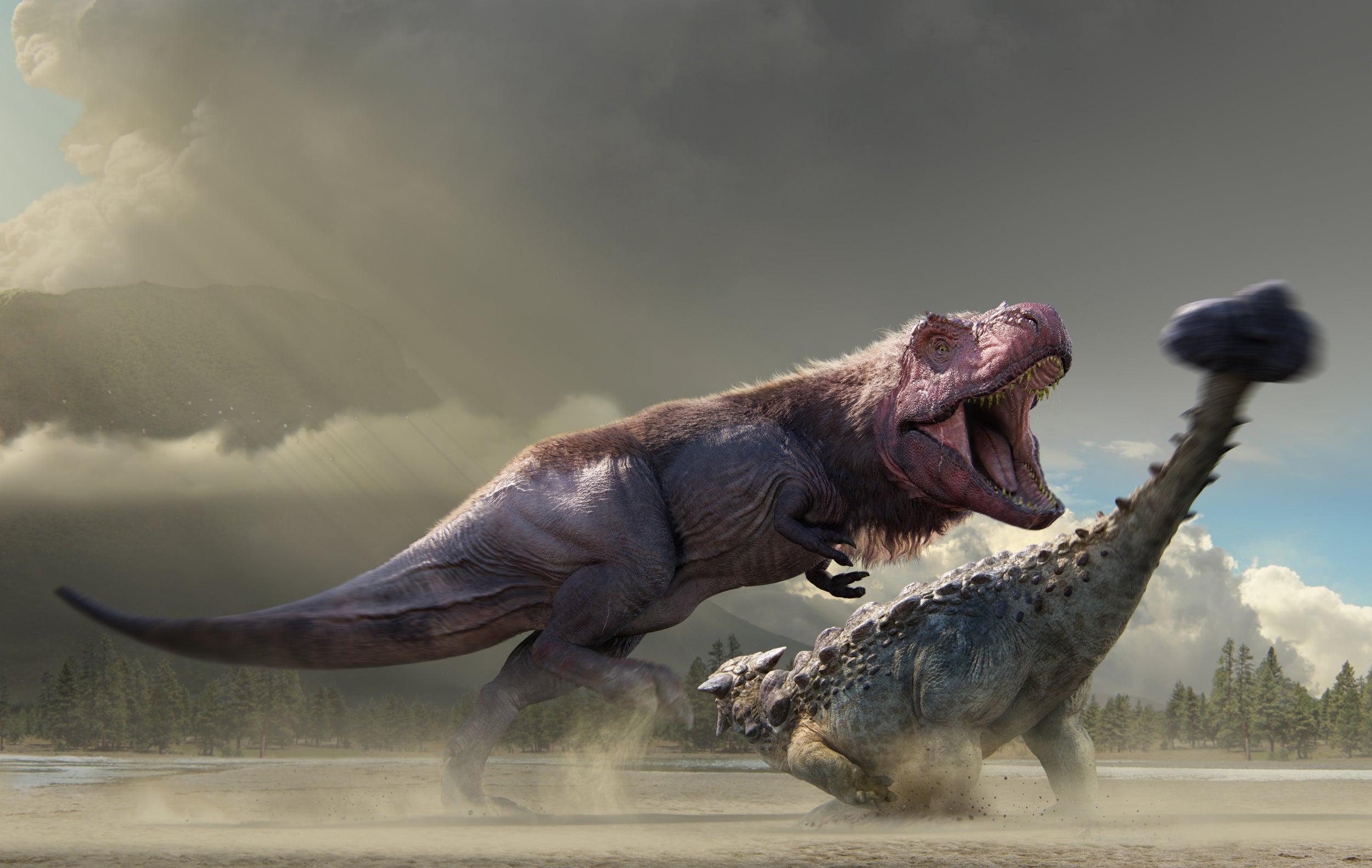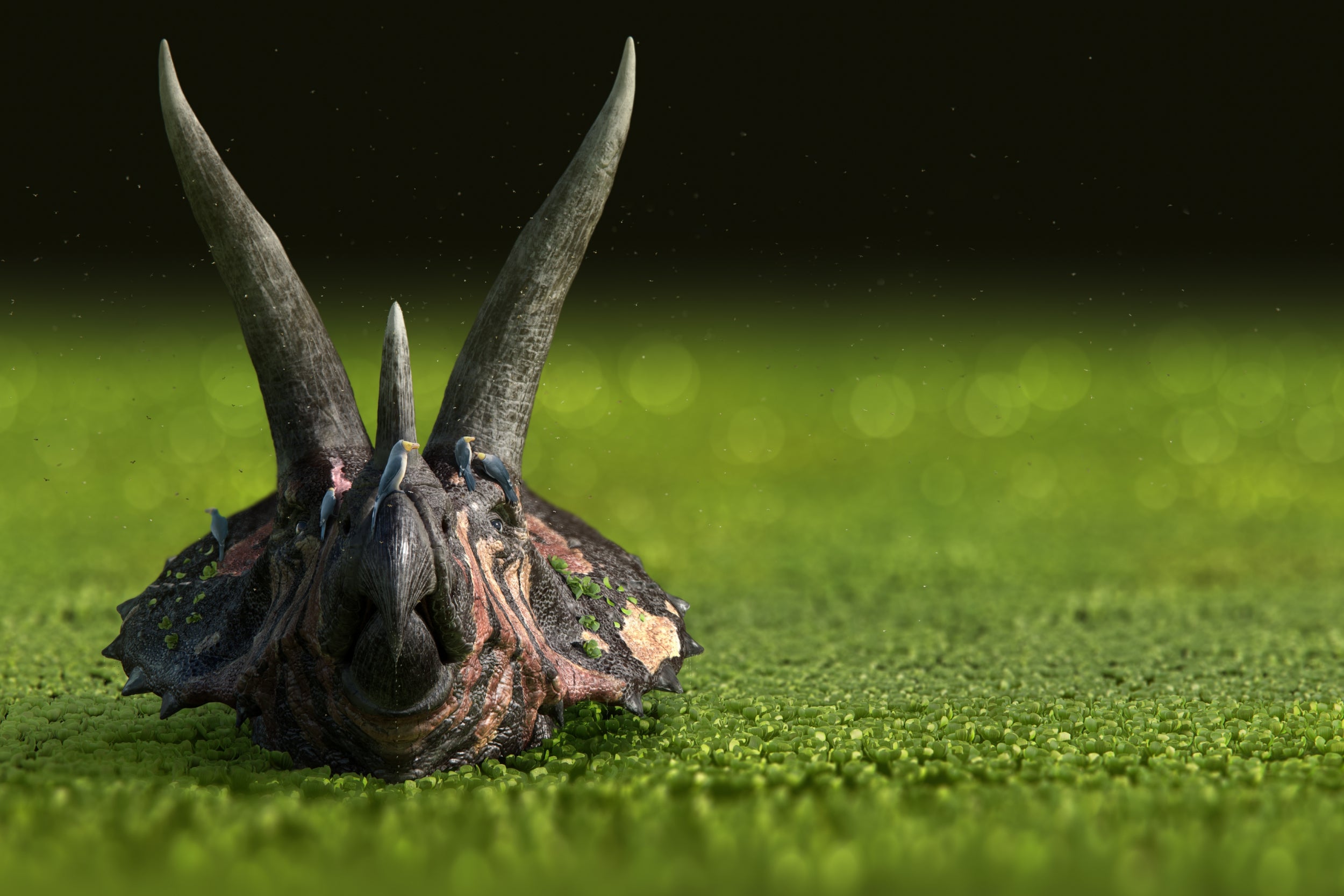25 years after Jurassic Park, our understanding of dinosaurs has evolved
A new exhibition shows that our knowledge of ancient creatures has moved on considerably – and it turns out dinos are even stranger than we thought
Your support helps us to tell the story
From reproductive rights to climate change to Big Tech, The Independent is on the ground when the story is developing. Whether it's investigating the financials of Elon Musk's pro-Trump PAC or producing our latest documentary, 'The A Word', which shines a light on the American women fighting for reproductive rights, we know how important it is to parse out the facts from the messaging.
At such a critical moment in US history, we need reporters on the ground. Your donation allows us to keep sending journalists to speak to both sides of the story.
The Independent is trusted by Americans across the entire political spectrum. And unlike many other quality news outlets, we choose not to lock Americans out of our reporting and analysis with paywalls. We believe quality journalism should be available to everyone, paid for by those who can afford it.
Your support makes all the difference.We are fascinated by dinosaurs. Ever since the first dino fossils were discovered in the early 19th century, we have been desperate to know as much as we possibly can about these remarkable creatures. And as our knowledge grows, so our perceptions change.
Imagine that time travel had been invented, and that for a limited time this summer you could journey back 67 million years to the Late Cretaceous and the Age of the Dinosaurs, to see animals like Triceratops and Tyrannosaurus roaming free in the landscape around you.
Such is the opening premise of Dinosaurs in the Wild, a unique, immersive and interactive visitor attraction based at the Greenwich Peninsula, in London, until 2 September. I have been involved as the scientific consultant. Our aim with this experience is to present an absolutely modern, science-based view of dinosaurs and their world – and I’m pleased to say it has won critical praise from the palaeontologists, palaeoartists and other experts who’ve visited so far. However, things are a bit weirder than you might imagine.
It’s the look of our dinosaurs, created using the latest photo-real computer generated imagery, that most strikes visitors. The creatures are boldly patterned, brightly coloured, often fuzzy, feathery or spiny, and with unusual features that make their fleshy outlines different from their skeletons. These aren’t the dinosaurs your parents or grandparents would have seen in the books or exhibitions of previous generations. Nor are they even the dinosaurs of cinema’s most notable dinosaur-themed outing, 1993’s Jurassic Park, nor of its sequels (including 2015’s Jurassic World and 2018’s Jurassic World: Fallen Kingdom).
Indeed, this week marks the 25th anniversary of Jurassic Park’s UK cinema release, and even now it has to be considered a milestone event in cinema. It took CGI, robotics and model-making to a new level, wowing audiences with the innovations and craftmanship of Steven Spielberg’s team, Stan Winston Studio and Industrial Light and Magic.
And from the perspective of science education as well, Jurassic Park was a major score. Gone were the solitary, tail-dragging, Godzilla-like monsters of yore. Instead we saw complex, group-living animals that walk and run like birds, keep their tails up off the ground, and are smart enough to ambush humans and negotiate the interiors of buildings.

In bringing this science-based view of dinosaurs to the silver screen, Spielberg naturally worked with expert consultants. The result was that the view of dinosaurs that emerged among palaeontologists during the late 1960s – a scientific and cultural event known as the Dinosaur Renaissance – found a new audience. So significant and inspirational was Jurassic Park’s scientifically informed view of dinosaurs that many professionals working on dinosaurs and other ancient animals today trace their nascent interest in the subject to the movie.
But if Jurassic Park was so on the ball, why are the dinosaurs in the new Dinsosaurs of the Wild attraction so very different? The answer is that much has changed in the past few decades in our scientific understanding of dinosaurs. So much so that 1993 feels like a long time ago, with the result that Jurassic Park’s dinosaurs are now surprisingly dated.
Notably, the people behind Jurassic Park opted not to feather their dinosaurs, specifically the bird-like predator Deinonychus (called Velociraptor in the movie). There are two takes on this issue. One is that the scientists of the early 1990s didn’t have sufficient fossil evidence to run with the idea of feathery dinosaurs. After all, a feathered, non-bird dinosaur fossil didn’t show up until 1996 (the term “non-bird dinosaur” is now a necessity given that birds are dinosaurs in the same way that primates are mammals). That fossil is the original specimen of Sinosauropteryx, a small, long-tailed predator that lived in eastern China around 130 million years ago.
But a second take is that, although the idea of feathery non-bird dinosaurs was looking really, really likely even in 1992-93 (the skeletons of early birds like Archaeopteryx and near-bird dinosaurs like Deinonychus and Velociraptor are extremely similar), the technological limitations of the time and Spielberg’s argument that a feathery Deinonychus just wouldn’t look scary led Jurassic Park’s creators to play it safe.
Two and half decades on and hundreds of feathered dinosaur fossils have now been unearthed from the same region that yielded Sinosauropteryx. These and other fossils found in recent times show that feathers and feathery-like filaments, quills and fuzz were widespread across the large group of bird-like, mostly predatory dinosaurs called coelurosaurs. Among this group are the tyrannosaurs. So – should tyrannosaurs be fuzzy or feathery as well?
The 2016 discovery of a giant, fuzz-covered tyrannosaur in China – the nine-metre long Yutyrannus – proves that big tyrannosaurs were indeed, just like their smaller cousins, in which case even the gigantic Tyrannosaurus should be reconstructed with a fuzzy coat. Based on this evidence, the Tyrannosaurus at Dinosaurs in the Wild has feathering across at least some of its upper surface. But this idea has since been contested: some experts argue that skin impressions show how Tyrannosaurus and kin underwent an evolutionary transition back to scaly skin. Argument here continues and more data is needed.

Dinosaurs were flamboyant, showy creatures. Frills, crests and horns on the head and sails and spines along the back were commonplace. Similar structures in living animals – cattle, deer, beetles and chameleons – are associated with sexual display and with battles that occur during the breeding season. Combine this with the fact that dinosaurs almost definitely had excellent colour vision – an inference based on eyesight in their living relatives – and the Age of Dinosaurs was surely flashy, colourful, even gaudy.
Jurassic Park and Jurassic World again opted to be conservative, there being much grey and mud brown but little else. We very much went for the opposite in Dinosaurs in the Wild. Our Triceratops has red striping across its face and enormous bony frill, our tyrannosaurs have bright red faces used in signalling and intimidation, and our feathery Dakotaraptor is patterned in black and white and has a red forehead.
Hard evidence for the colours of dinosaurs is rare but does at least exist: microscopic cellular structures termed melanosomes were reported from dinosaur fossils in 2010 and have so far been identified in around eight non-bird dinosaurs. They reveal evidence for colours, patterns and even iridescence on the feathers and skin of select species, and more such discoveries are sure to be forthcoming now that experts know what to look for.
New thinking also has it that dinosaurs were not just gaudy and colourful. As explained in the 2012 book All Yesterdays, both the anatomy of living animals and a number of “known unknowns” and “unknown unknowns” (thanks, Rumsfeld) render it likely that dinosaurs were sometimes weirder in anatomy than long thought. Air-filled sacs distributed throughout the body and skeleton, enormous bony hollows surrounding the nostrils and evidence for big masses of erectile tissue on the face suggest that some dinosaurs had inflatable or erectile wattles, dewlaps, sacs and other structures. This sounds odd but such structures are present in many modern birds and would be hard or impossible to predict if we only knew these animals from their bones.

It’s for this reason that the gigantic, armour-plated Ankylosaurus in our vision possesses inflatable facial structures best described as cheek balloons. Surprising yet plausible features like this may well have been commonplace across the dinosaur world.
Finally, what about behaviour? The Jurassic franchise has always made nods to the idea – made scientifically robust during the Dinosaur Renaissance – that dinosaurs of many sorts were more social and behaviourally complex than the solitary brutes of convention.
Fossil nests discovered in the 1970s showed that dinosaurs of several sorts nested colonially, that nest-building and nest-care were common, and that at least some species guarded their babies and even provisioned them with food. Baby dinosaurs preserved away from the nest environment are typically found in groups and are sometimes found in association with the remains of an adult.
And both tracks and assemblages of skeletons show that many dinosaurs lived in groups, ranging from twos or threes in big predators to tens or hundreds in the case of many plant-eaters. It remains open to debate as to whether Deinonychus and its kin used the coordinated group-hunting portrayed in Jurassic Park, but the door is certainly open for social behaviour of many kinds.
One very specific behavioural nugget does separate Jurassic Park from Dinosaurs in the Wild. Our dinosaurs don’t roar like lions. Roaring with a wide-open mouth seems normal to us, because we’re mammals. But dinosaurs aren’t mammals, and if we look at their closest living relatives – crocodylians and big birds like emus and ostriches – we see that loud sounds are made with a closed mouth, the noises emanating from the throat and chest.
Maybe this is an example of science ruining something that seems awesome and dramatic. Or maybe this is one of those cases where we benefit by having our assumptions corrected by discovery; where we learn that nature is sometimes different from that which we might expect.
Add all of this together, and science is revealing a colourful, vibrant, complex Age of Dinosaurs quite different from the one imagined back when Jurassic Park was under production. Dinosaurs in the Wild presents the scientific state of the art as it stands in 2018. But much remains to be discovered and a scientific attraction constructed decades from now may well look even more remarkable.
Dr Darren Naish is a palaeontologist and scientific consultant at Dinosaurs in the Wild. Having thrilled time travellers in Birmingham and Manchester, the experience is now established at a custom-built home on London’s Greenwich Peninsula, a short walk from North Greenwich Underground station, until 2 September. Tickets can be booked here

Join our commenting forum
Join thought-provoking conversations, follow other Independent readers and see their replies
Comments